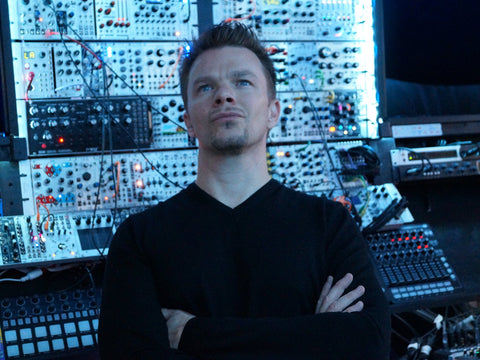
Have you ever seen a spaceship? Neither have I (well, in real life), but I imagine one must look like our very own Attila Hanak's studio "The Sixteenth Bar" in Toronto.
The Mind Behind Push 2 Masterclass
Attila is the creator of our best-selling Push 2 Masterclass, where he teaches you how to take full advantage of Ableton with the midi controller "Push 2". The new must-have workflow enhancer from Ableton themselves.
If you want to start creating music by real feel rather than robotically programming everything with your mouse, check out great the midi-controller Ableton Push now.
Attila originally gave our friends over at MusicTech a studio tour, and we enjoyed it so much we decided to share it here as well.
Let's do a deep dive right into Attila's dream studio...

Where is your studio? Tell us more about it.
The studio is located in Toronto. It is a work in progress and has been for the past three years. I’ve been refining the layout and the setup to aid me in a rather specific method of music production, which is based mostly on merging the benefits of the hardware world with the flexibility of the digital realm.
What’s your favorite DAW?
Ableton 10.1 Suite. I’ve never tried another DAW, so I wouldn’t be able to give a good judgement on a comparison, but Ableton does what I need it to do, how I need it to do it, and by now I’ve become familiar and proficient enough with it to use most of its functions with a second-nature ease. Also, the new CV Tools have proven to be a game-changer when it came to integrating external gear into a production, so that’s a massive plus.
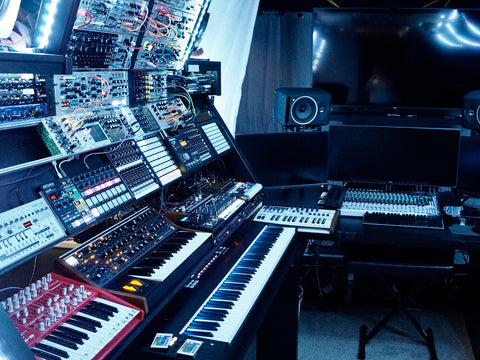
What’s your favorite piece of gear?
That’s a difficult question to answer, simply because there are so many amazing pieces of gear I could call my favorites, for a number of reasons. If I had to choose one, I’d have to go with the Moog DFAM. It’s just an amazing machine. I’ve used it in a number of vastly different applications. It’s about as analog as it can get, it sounds stunning and it’s temperamental. Once I start playing with it, I just can’t stop. Another interesting thing with it, is that you never know what will come out of it. Each session is completely different. I also like the Eurorack integration possibilities.
What is your dream piece of gear?
Funnily enough, my dream piece of gear is a synth I’ve never seen or touched. I haven’t even heard it being played live. There was a YouTube video from Junkie XL Studio Time where Tom was showcasing a Korg Trident. All it took were three minutes of him playing a few notes and I fell in love with it. One day perhaps I’ll get it.
How do you control all the gear in your studio?
I have a MIDI matrix set up which is accessible from both computers in the studio, as well as an 88 key MIDI keyboard. In the heart of all this is a 10 channel MIDI interface. Most standalone synths like the Sub 37 and the MiniBrute, as well as the drum machines all have their own MIDI inputs, and OSCAR (the Eurorack wall that I decided to name Oscar for whatever mysterious reason) has 4 MIDI to CV modules to fulfil this function.
This way, I can send MIDI to nearly all of the gear simultaneously via a large number of MIDI tracks from Ableton. In addition to that, I also use an Expert Sleepers ES-8 DC-coupled USB audio interface to use Ableton’s CV Tools, which again just opened a whole myriad of possibilities to modulate external gear and to automate functions throughout the arrangement of an entire song, or perhaps even a longer live performance.

What attracted you to modular?
My first synth was a MiniBrute, then the Moog Sub 37. Soon after I got the Sub 37, I found myself patching the MiniBrute’s audio out into the 37’s external input, then using the few CV outs of the Brute to mess around with the Sub 37’s filter via ¼” to ⅛” patch cables and its CV inputs. It quickly became obvious that I had a thing for twisted cables and fancy turn-knobs. Then I realised there was a better way to do that; enter the black hole of Eurorack.
My first purchase was a few MakeNosie modules, and after staying up for two days straight playing with them, I have never looked back. Modular has those same qualities that I mentioned to love about the DFAM. It’s an instrument that you have to learn to play and that takes time, so it’s definitely not for everyone. It can look intimidating, but if you treat it with respect, have patience with it (and a lot of free time to kill) it can give you the kind of payoff that you’ll never get from a VST, or even a pre-wired synth. I must emphasise “patience”; it’s usually a few hours of frantic patching and potentially a great deal of frustration to finally arrive at a sound that pleases you.
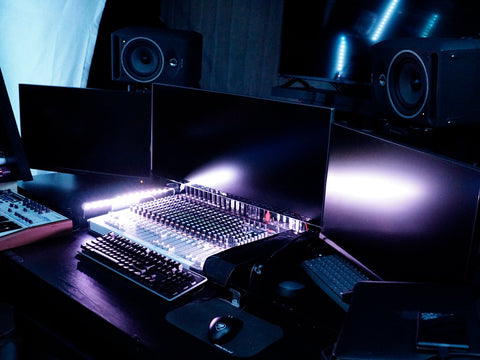
How much time do you spend in your studio?
Since I’m a one-man-show, I have to spend a lot of time in the studio. I’m usually there a good 10 hours per day on average. When I’m working on a larger project, like the Push 2 MasterClass for you, I can easily be there 14 to 16 hours per day, or until the work is done. Sometimes it’s when fatigue sets in… it’s whichever comes first.
What do you use your studio for?
Other than having fun experimenting with different things and coming up with new ideas, I use it mainly for three things: Producing music, producing videos and creating sample packs for my website. From starting patching up sounds on Oscar, arranging the timeline and then recording the elements, then mixing the tracks and mastering the song, everything is done in the studio.
I’ve created all my sample packs on Oscar, recorded in their purest form with no unneccessary processing.
I also have a YouTube channel where I make educational videos about music production. I’ve learned so much from other creators, selflessly investing their valuable time, to put up amazing free contact on the web. Now it’s my time to return the favor. So if my time allows, I make videos for my YouTube channel to share my knowledge with other producers.
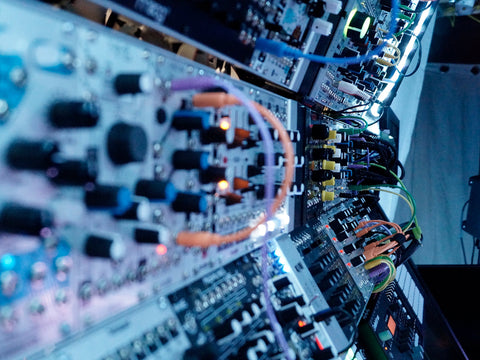
If you could give one piece of music production advice, what would it be?
Less is more.
What do you wish you knew about synthesis/synthesizers when you were starting out?
Nothing really, in addition to what I already knew. It has been an amazing journey with no regrets. I didn’t really experience a huge epiphany or defining moment halfway through, that would have wanted me to stop, go back, and ask for my money back. On the contrary actually; the deeper I got into it, the more enjoyable it became. I don’t think there are any limits that can ever be set with respect to knowing it all. There’s always more to learn and more to discover. If you ever meet someone who says they know everything about synthesis, just laugh out loud and walk the other direction real quick.
What is the one piece of advice you would give to someone starting out building a studio?
Take it slow. Study your options before pulling the trigger on any purchase. There’s virtually an unlimited number of good tutorial videos on nearly every piece of gear available, so you can do your homework. Once you do buy something, learn it inside out, and don’t allow yourself to get a new piece, until you’re fully familiar with this one. Even if you’re rolling in it… it’s just better this way! Same goes for VSTs; chances are your DAW already has a native plug-in that’ll do the job well, shiny doesn’t necessarily equal better. It’s all about knowing how and when to use which parts of your gear, and at the end of the day, your money may be better spent on something else, rather than a 147th compressor plug-in in your arsenal.
|
Thanks for reading, and see you in the next article! Get in touch and learn more about Attila Hanak here: thesixteenthbar.com | youtube.com/TheSixteenthBar | info@thesixteenthbar.com |
|
Pelle Sundin is a Swedish music producer, currently active with his chillout project PLMTRZ. As a contrast to his more mellow tunes, he also produces psychedelic trance. When he's not producing music, he surfs, writes and chugs coffee. |
P.S.
With Push 2 from Ableton, you can fully control your Ableton interface from the push of a few buttons. Whether you're producing or want to take your live sets to the next level, the Push 2 is a vital piece of gear.
Does the Push 2 with all its buttons feel complicated?
Trust me, it's not!
Make Music "By Feel" And Take Your Live Sets To the Next Level - with Push 2 Masterclass
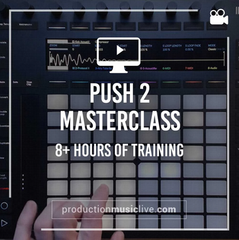
In our Push 2 Masterclass, we'll take you for a deep dive into Push 2, teaching you all its features, settings and workflows.
Just a few hours after unboxing - become an absolute expert in how to work with this incredible midi controller... whether in the studio, or playing live in a club.
In Only A Few Hours, You'll Learn How To:
✓ Build a Complete Track Using Push 2
✓ Produce Better Music With the Push 2
✓ Create Incredible Scales and Melodic Pads
✓ Make Your Drum Loops Finally Sound As They Should
✓ Setup And Optimize Push 2 To Fit Your Workflow
... and much more.
Get instant access and learn everything about Push 2 now.
Click Here
Watch the introduction video for the course here:
